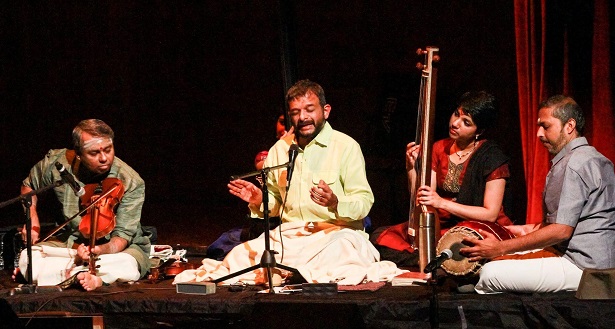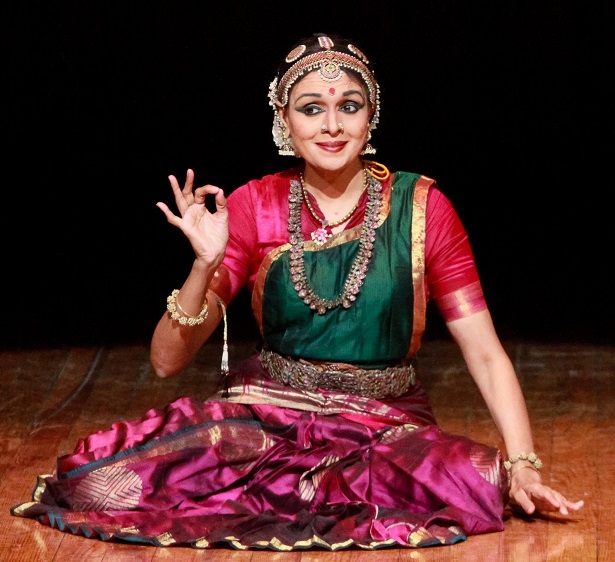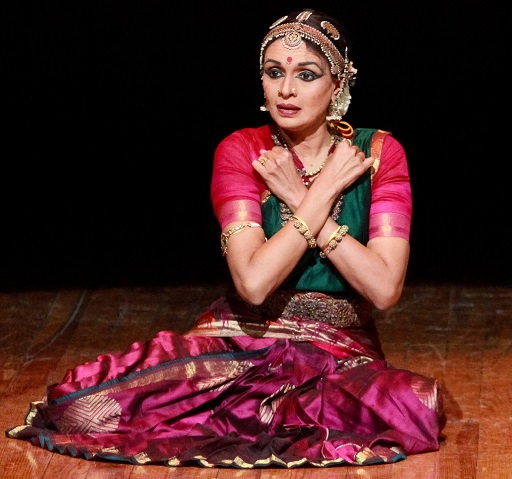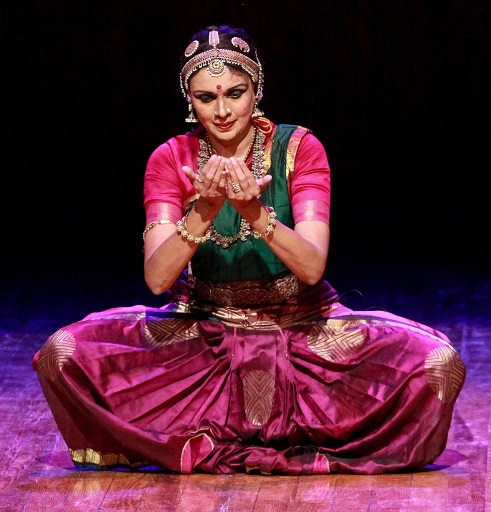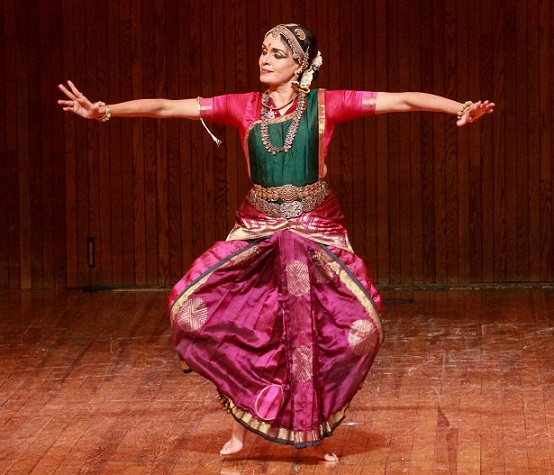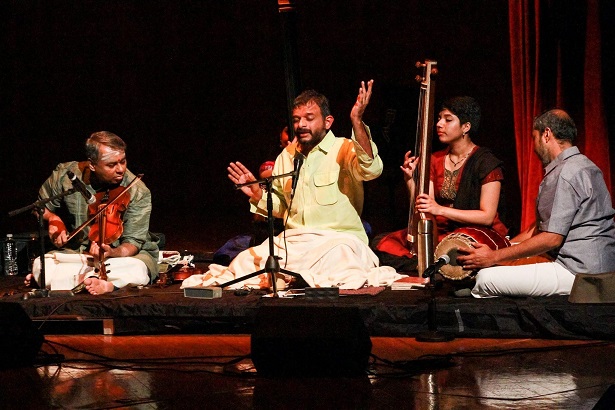Contribute
| “Saayujya†- A Wholesome Audio-Visual Treat For Boston Audiences |
Shuchita Rao
05/12/2016
“Saayujya†- A
Wholesome Audio-Visual Treat for Boston Audiences - Swara, Laya and Bhaava merged to create an immersive
audio-visual experience in Vidwaan T.M. Krishna’s and Vidushi Priyadarshini
Govind’s unique classical music and dance collaboration held on May 7 at MIT in
Cambridge, Mass. The production titled
“Saayujya†was a fundraiser event for the MITHAS (MIT Heritage of South Asia) organization
which has worked for over two decades to enrich our environment by providing
exposure to the great heritage and traditions of Indian classical arts in the
New England region. The spacious stage in MIT’s Kresge auditorium with a rich
wooden paneled background needed no decoration. The danseuse Priyadarshini
Govind dressed in a pleasing magenta and green dance costume with elegant
jewelery lit up the entire stage with her alluring presence. In a departure
from the conventional stage setup for classical dance performances, the team of
musicians (consisting of the vocalist Vidwaan T.M. Krishna, violinist Vidwaan Sri.
R.K. Shriramkumar, Mridangam artist Vidwaan Sri. K. Arun Prakash and two taanpura
players) sat on a separate raised platform, at a distance from the nattuvanar
and the mridangam artist who primarily provided accompaniment to the dancer. Vidushi Priyadarshini Govind, a foremost exponent of
Bharatanatyam who currently heads the premier classical arts institution in
India, the Kalakshetra foundation, is a disciple of stalwart Gurus Sri. S.K.
Rajarathnam Pillai and Kalanidhi Narayanan.
Vidwaan T.M. Krishna, a renowned classical vocalist who is known for
engaging deeply with the improvisational possibilities in Carnatic music is a
disciple of Guru Chengalpet Ranganathan and the legendary Semmangudi Srinivasa
Iyer. Both artists had a fabulous team of accompanying artists enhancing their
presentations. Together, with a creative sound and lights manager, the team
successfully transported the audience to a magical world. Eight items were presented in a three hour long show without
an interval, some of which centered around classical music such as the
Keerthana in Ragam Paraju “Neelayadakshiâ€, some purely around Bharatanatyam
dance such as Alarippu in roopaka taalam and the rest which were collaborations
in which all the artists performed together.
Stage lights served the important purpose of creating dramatic effect through
the use of light and shade by focusing at times on just the dancer, at times on
just the musicians and at other times on illuminating the entire stage. In the opening alarippu dance item, elements of pure dance
“nrittaâ€, took the spotlight. The dancer’s poise, her controlled head and neck
movements, her perfect stance were enhanced by the nattuvanar Sri. K. S.
Balakrishnan’s nattuvangam and crisp and modulated delivery of jathis as well
as the mridangam artist Sri. Vedakrishnan Venkatesan’s nuanced accompaniment on
the mridangam. Next, a vocal rendition of the keerthana composed by Sri. Shyama
Sastri, “Neelayadakshi†was marked by a dynamic and flowing quality in the presentation.
In the third item, a daaru varnam “Maate Malayadvaja†composed by Sri. Muthiah
Bhagavatar and set to Raga Khamaas, Vidwaan T.M. Krishna had created a
devotional atmosphere with his evocative alaapana. Vidushi Govind joined in the
latter half where beautiful swara jathis came into play. In this particular
item, was creation of synergy by the accomplished artists, each of whom was a
consummate performer in his/her own right. In a collaboration themed on the topic
of “Democracyâ€, conversation
and exchanges between world leaders such as Nelson Mandela, Tagore, Meera, Adi
Shankara, Ambedkar, Rosa Parks and Barathiyar were woven together through multiple
ragas, languages, instruments, music and
dialogue. Nattuvangam accompanying an English song titled “Dream†sung by Joan
Baez was a creative idea of how different cultures could find common ground to
convey the basic human needs for freedom and liberation. The choreography was
unique and several human emotions such as fear, anger as well as peace and joy
were depicted powerfully by Govind. T.M.
Krishna’s rendition of Meera’s composition “Pug Ghunghroo bandh meera naachiâ€
and the original bangla composition for “Where the mind is without fear and the
head is held high†by Rabindranath Tagore were received well by the audience. Vidushi Govind’s brilliant abhinaya
poured life into composer Pattabhiraamayya’s javali “nee maatalu maayamura†. She effectively portrayed a naayika
who teaches her charming and insincere lover a lesson by closing the door on him.
The sounds of the initial knock and the final closing of the door were executed
with great flourish. Following the javali, a padam
without rhythmic accompaniment and an imaginative thillana composition showcased
an interesting usage of a variety in ragas and rhythmic patterns. Vidwaan R.K.
Shriramkumar and Vidwaan T.M.Krishna who created the thillana together
added taanam to the thillana
constituting a unique aspect to the composition’s architecture. The concert ended with a
collaboration on “Vande Meenakshi Tvamâ€, a Sanskrit nottuswara composition by
Sri. Muthuswamy Dikshitar. Based on an Irish tune “The Rakes of Mallowâ€, the
rhythmic composition was rendered in a slow tempo and left viewers with a
feeling of fullness and completion after a grand feast. Whether it was the exploration of
“sringara-bhaktiâ€, an expression of love between human and the divine or of
“sringara-romance†, an expression of love between man and woman, the variety
of devotional, romantic and rhythmic compositions presented through poetry,
dialog, song and dance captivated the hearts of those who attended the
“Saayujya†production. “I was in tears the whole time†said Sowmya Rajaram, an
accomplished Bharatanatyam dancer from Boston after the show. Kudos to MITHAS , the artists, the
sponsors and the volunteers for this unique presentation that proved that
Indian classical arts can effectively portray and communicate the universal
theme of conflict that is embedded in the human condition all across the world.
You may also access this article through our web-site http://www.lokvani.com/
